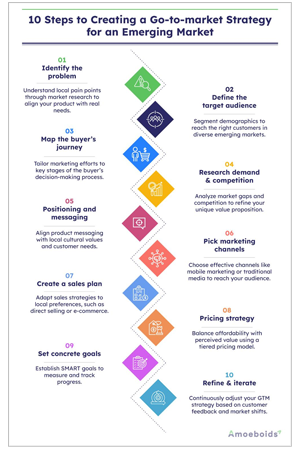Go-to-Market Strategies for Emerging Markets: A Step-by-Step Guide

Are you interested in grabbing the humongous opportunities present in emerging markets?
Well, these market areas have unique challenges and are growing quickly, which makes them exciting places for creative businesses.
But is it possible to navigate these surroundings effectively and smoothly?
Yes, it is possible to explore developing markets successfully and smoothly if you have the correct GTM strategy.
In this blog, we will cover the steps for building a successful go-to-market strategy. It will ensure that your product meets needs and stands out in markets.
What is a go-to-market strategy?
A go-to-market is a strategic plan that companies use to improve their efficiency before launching their products in the market. It includes product positioning, identifying specific customers, understanding market needs, marketing, sales strategies, and pricing.
It outlines how a company plans to sell its products to customers and stand out from their competitors. Every aspect of a product’s launch and distribution is considered by a successful GTM strategy. It ensures that the goals of the companies and customer needs are in sync.
Why is the GTM strategy necessary for emerging markets?
Although emerging markets present growth prospects, there are risks associated with them because of changing economic landscapes. GTM strategies ensure success in these uncertain markets by reducing risks and enhancing resources. The detail points are listed below:
- Emerging markets have cultural differences and consumer behaviors that differ from developed economies. A GTM strategy modifies the business strategy to align with regional customs, linguistic preferences, and traditions.
- Emerging markets have very different consumer expectations and needs. Even in situations where price sensitivity is high, companies can promote brand loyalty by providing an attractive value proposition.
- Emerging markets have very different regulatory environments. A GTM strategy ensures that businesses stay out of problems and adhere to local regulations.
- Even in new markets, a GTM strategy helps companies highlight their limited resources on the best marketing and sales channels. It ensures a faster journey to financial success.
10 steps to creating a go-to-market strategy for an emerging market
When entering emerging markets, it is necessary to develop a GTM strategy that matches with the unique changes of the local market. This is a step-by-step guide to boost opportunities while managing difficulties.

- Step 1- Identify the problem: Any GTM strategy starts with recognising the customer pain points that your product helps to address. To understand the various issues that customers in emerging markets face, extensive market research is required.
Products that are cheap and simple to use could be essential for resolving everyday problems in places with insufficient structure. Your product will be valuable and relevant to the real needs of your target market if the problem is defined within the framework of the local market.
- Step 2- Define the target audience: It is critical to specify the target market after determining the problem. Segmenting demographics such as age, gender, location, income level, and purchasing behaviors is necessary for this. Custom audience segmentation is important because emerging markets are often very different from one another.
For example, a younger, tech-savvy population might embrace new products more rapidly. This highlights your marketing and sales efforts. It also ensures that your product reaches the right customers.
- Step 3 – Map the buyer’s journey: It is important to understand how customers in developing economies decide what to buy. The buyer’s journey may be influenced by the views of local vendors, the community, or family members.
Customizing your marketing campaigns at crucial points in the customer journey, like awareness to purchase, can increase their chances of success.
- Step 4 – Research demand & competition: A successful entry requires a detailed analysis of the competition and market demand. There might be unmet demand in some markets and established competitors in others.
You can find pricing trends, market gaps, and your unique value proposition by conducting a competitive analysis. This helps you figure out how to set your product apart from the competition.
- Step 5 – Positioning and messaging: It is critical to position your product so that it appeals to the local market. Cultural values, beliefs, and aspirations should all be reflected in messaging.
Durability and affordability might be valued more highly than luxury in many emerging markets. Messages that are clear, culturally appropriate, and meet customer needs can make a product more appealing.
- Step 6 – Pick marketing channels: While traditional media like radio and billboards may still play a larger role in emerging markets, mobile marketing is becoming more and more popular.
This is especially true in areas where smartphones are widely used. Choosing the appropriate marketing channels is critical for effectively reaching your specific customers.
- Step 7- Create a sales plan: Strategies for sales should be customized for local behavior. Retail chains may not perform as well in some areas as direct selling or partnering with local vendors.
Platforms for e-commerce may also be successful in areas with robust digital infrastructure.
- Step 8 – Pricing strategy: In emerging markets, pricing must strike a balance between perceived value and affordability. Although they are price sensitive, customers are willing to pay for quality.
You need to create product packages or a ranging pricing structure to serve a range of economic markets.
- Step 9 – Set concrete goals: The secret to tracking success is to set SMART goals with specific, measurable objectives. By tracking customer acquisition, sales volume, and market penetration, these goals allow for timely corrections.
- Step 10- Refine & iterate: Your GTM strategy must be adaptable. After launch, get customer feedback regularly and adjust your strategy based on what works to keep your product relevant in a changing market.
Conclusion
With a creative go-to-market strategy provided to local needs, you can unleash the potential of emerging markets. This direction provides you with all the resources you need to succeed, from thorough research to flexible execution.
Take advantage of new opportunities to expand your business. Buckle up to establish your presence right now.








